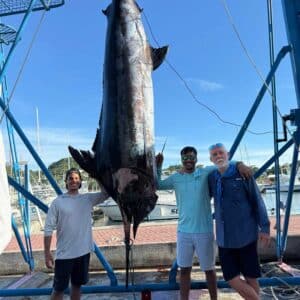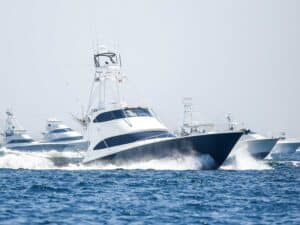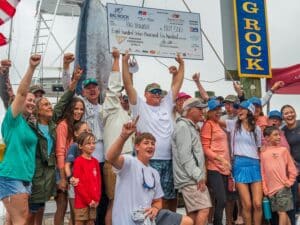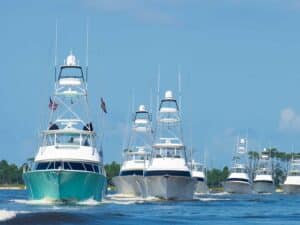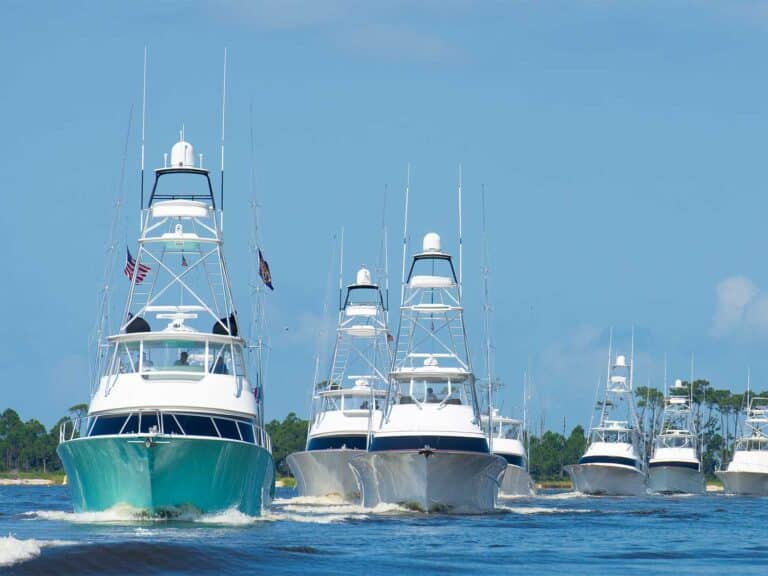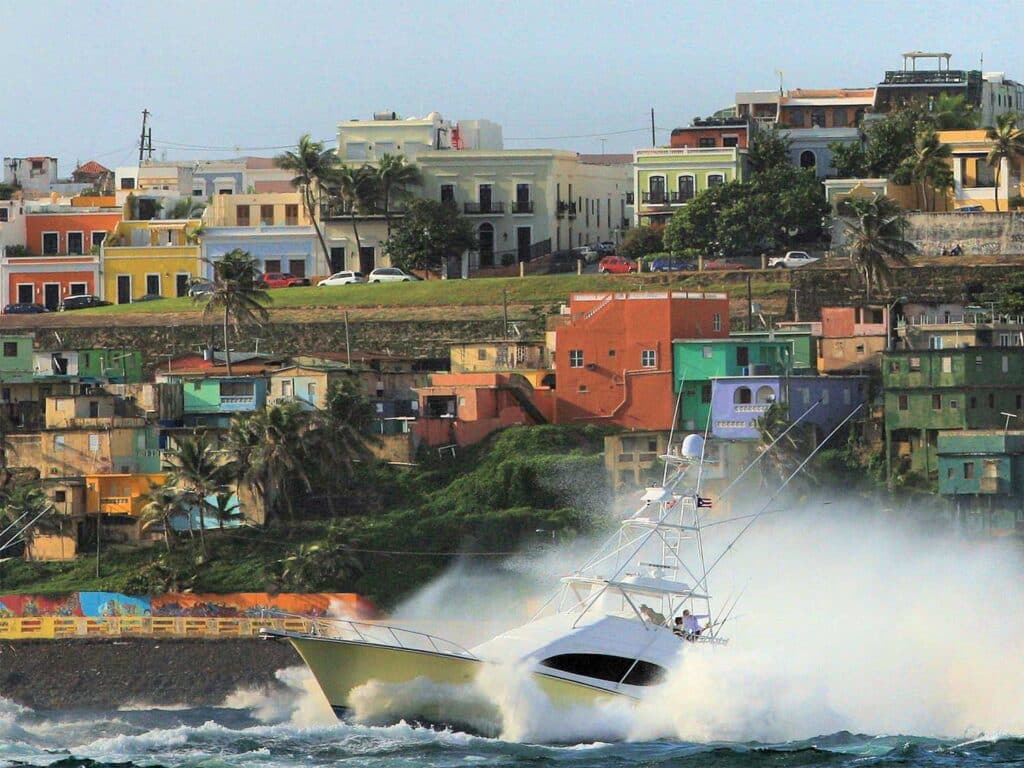
Special delivery: Sign up for the free Marlin email newsletter. Subscribe to Marlin magazine and get a year of highly collectible, keepsake editions – plus access to the digital edition and archives.
Since its founding in 1930, Club Náutico de San Juan has championed Puerto Rico’s nautical lifestyle for more than 90 years. This island nation, the gateway to the Caribbean Sea, has always celebrated its relationship with big-game fishing. That love affair naturally led to the creation of the International Billfish Tournament of San Juan, which has now become the longest consecutively running big-game fishing tournament in the world. This year, the event celebrates 70 years of history, competition and camaraderie—from the shotgun start and flag ceremony to the closing awards celebration, it’s a sport-fishing spectacle like none other.
The club began, not surprisingly, as one dedicated to the gentlemanly sports of sailing and yachting, attracting boats of all kinds in those early years between the world wars. And while the world was gripped by the Great Depression for nearly the entire decade of the 1930s, the wind was free, and so a grand regatta was held in 1930, drawing boats from across the island. Three years later, the foundation for Club Náutico de San Juan’s headquarters was laid next to San Antonio Channel, a location where the institution remains today.
An International Audience
With club member Chilo Bird volunteering as the first chairman of what became known as the International Billfish Tournament, the club held its first event in 1953. Even from its earliest years, the international attraction was undeniable. While those early years saw the event as primarily an interclub tournament for the various fishing clubs on the island, it also was among the first to invite international teams from the Anglers’ Club of New York and the Miami Beach Rod & Reel Club, eager to experience the opportunities to catch blue marlin in an idyllic Caribbean paradise. Bird remained as director for six years, and the tournament was up and running.
The IBT also dovetailed nicely with the Puerto Rico Tourism Company’s vision to promote sport fishing as a major attraction for visitors from not just the US, but from around the world as well, which they had been doing since the late 1940s. They invited prominent anglers from other nations to the event in order to share their knowledge and experience in other fisheries. Those anglers returned home with tales of plentiful blue marlin plus friendly locals and a beautiful destination, traits that hold true all these many years later. It was during this time that many significant club members came to the forefront as well, including but certainly not limited to Miguelito Ferrer Jr., Ralph Christiansen Sr., Carlos Gual and Juan Casellas, among others. Today, their sons and families have formed the next generation of members and directors, and they proudly carry on the traditions that were established so long before.
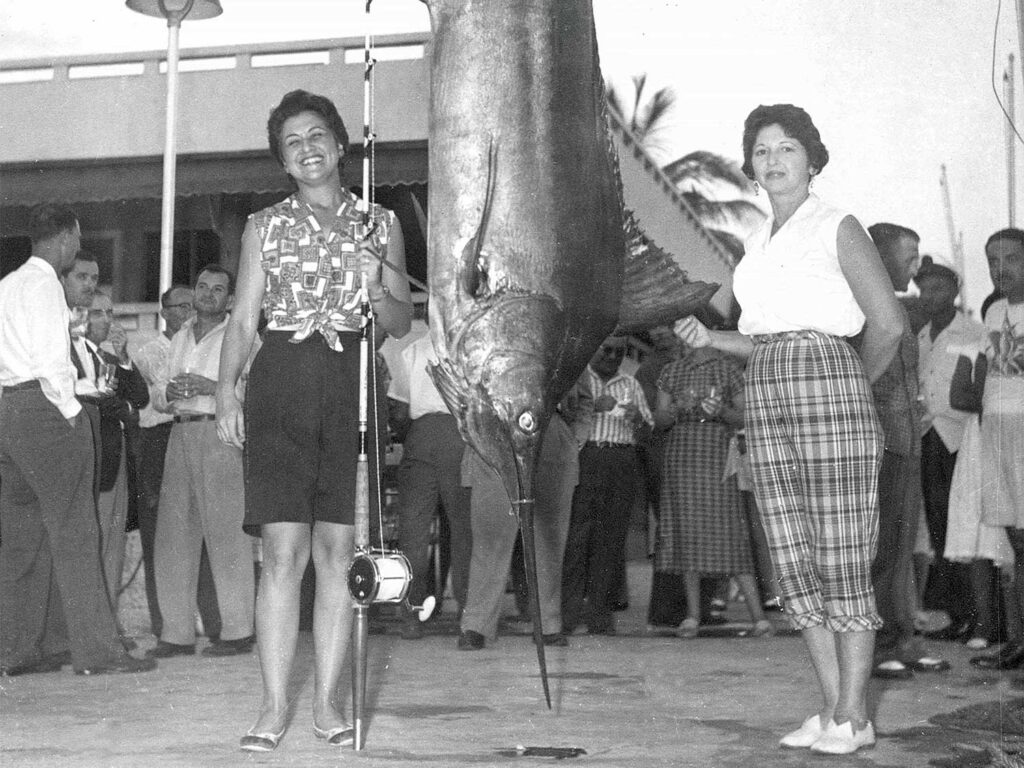
Records Tumble
Few would argue that the blue marlin fishing off Puerto Rico in general, and San Juan specifically, was nothing short of world-class right from the start. Blues were plentiful in both size and quantity, and the fishing grounds were located just a short run from the harbor. In 1956, Allen Sherman set the tournament’s first record by catching a 756-pound blue marlin on Sea Queen II. In 1959, Joseph Widdowson pushed the record higher with a 780.5-pounder. In 1988, the event set a world record with 190 blue marlin caught in a four-day fishing tournament, a record that remained unbeaten for many years afterward. Finally, in 1997, one of the last years in which blue marlin were allowed to be boated in the IBT, Luis Viyella landed an 895.5-pound fish.
During the 1980s, the tournament continued its growth on an international level, with Luis Acosta serving as director. Throughout the years from 1981 into the 1990s and beyond, competitors from across the globe have competed as part of the tournament’s coveted international division—not for big cash prizes, but rather for beautiful trophies and the bragging rights that come with a prestigious victory. For a level playing field, competitors use 50-pound-class tackle and must adhere to IGFA angling rules throughout the event.
One of the significant cornerstones of the IBT has always been a dedication to conservation. Thanks to its forward-thinking directors and club members, the event established a tag-and-release division in 1987, well before minimum lengths were mandated for blue marlin. Additional conservation measures were added until 2003—the tournament’s 50th anniversary—when it went to an all-release format for billfish.
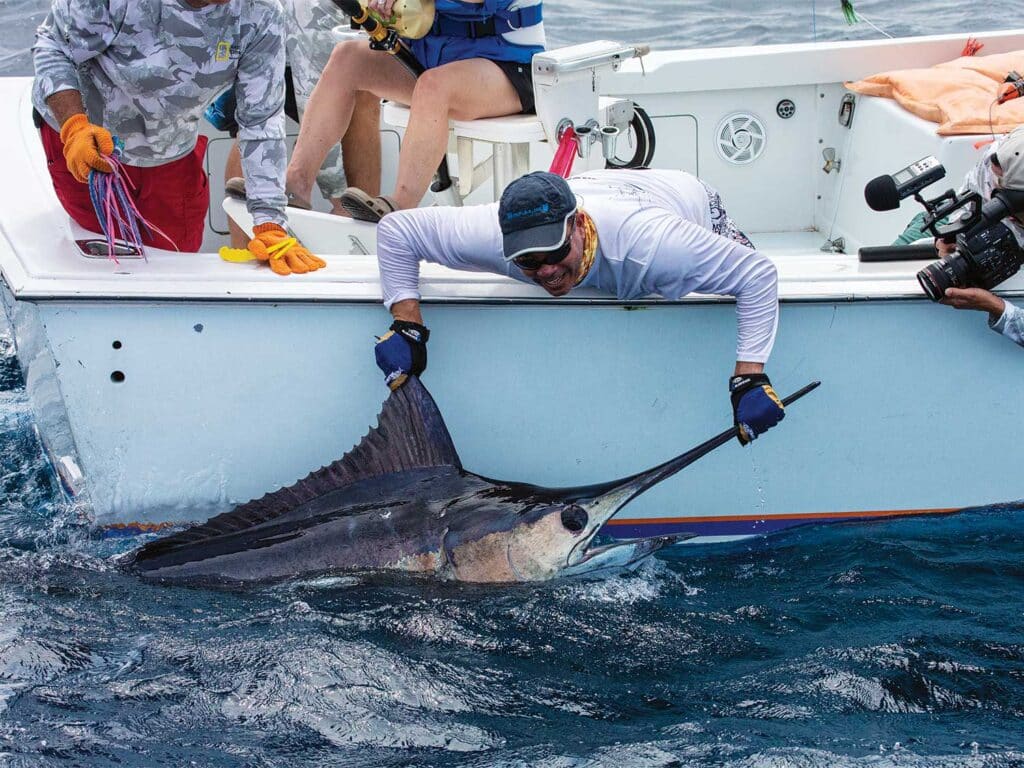
Teams, Clubs and Anglers
There are many different layers to the IBT, which is one reason for its popularity and longevity. It serves as an interclub tournament, attracting participants from fishing clubs across Puerto Rico to San Juan, where they battle it out. Believe me, the competition is fierce, but the smack talking is pretty world-class too. Visiting individual anglers can participate as well. At registration you’re assigned to a different boat each day, where you join that team’s anglers in an hourly rotation around the rods in the cockpit. All of the blue marlin caught by any angler on board is scored for that boat, but those fish also earn points for the individual angler who caught the fish. It’s a system that works well—it’s fair and competitive. A bonus for visitors: You get to meet and fish with a bunch of different people during the week. In Puerto Rico, you make friends quickly.
One attractive aspect of chasing blue marlin here is the proximity to the fishing grounds. Just a few miles from the entrance to San Juan Harbor, the depths plummet sharply amid a series of undulating underwater hills, valleys and trenches. Most of the action is easily within sight of land, and mostly within cell range as well. Just don’t tell the boss.
In a move to further concentrate the fishing action, the government has deployed a series of fish-attracting buoys on the northern end of the island. The first round of FADs were unfortunately destroyed by Hurricane Maria in 2017, which also knocked out a majority of the island’s power grid for several months. But today, a new set of FADs is back in action and producing good fishing.
New Names, Same Great Events
So, what does this year’s 70th-anniversary event hold? According to tournament director Richard Christiansen Jr., it will be an exciting mix of new names and sponsors, as well as old favorites, with that legendary Puerto Rican hospitality in overflowing supply—plenty of great cocktail parties each evening with no shortage of rum.
One of the club’s younger directors, Christiansen brings in a rich family legacy to the event. In fact, the main dock is named after his grandfather, who was club commodore at the time, and with his peers, spearheaded the effort for it to be initially constructed. Today it’s being replaced with a modern floating dock that’s designed to better resist the frequent storms as well as to accommodate larger vessels.
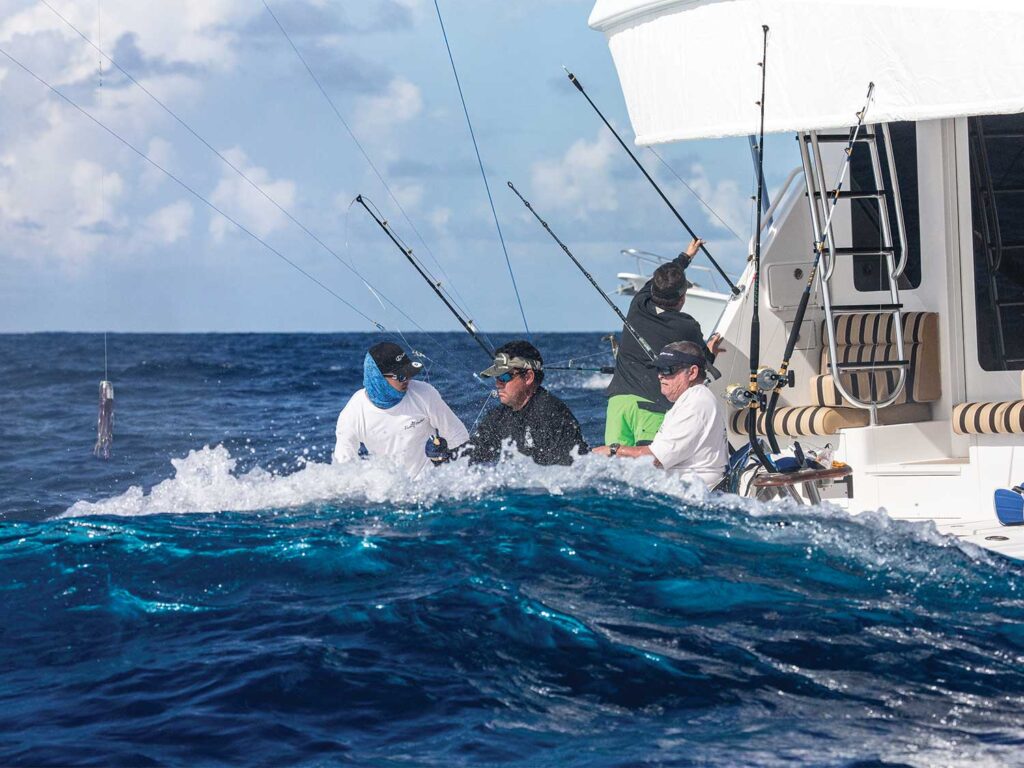
“I’ve fished this event for many years with my family,” Christiansen says, “and when the club wanted to bring in some new blood, I worked with Roger Casellas for the last couple of years when he was director. That’s one of the benefits we have here—there are so many club members who are passionate about fishing and who take the time off from running their own successful businesses to put in the time and energy necessary to be a director. I had not considered dedicating the 70th-anniversary event to any one individual, but in fact, it will be dedicated to all those great directors we’ve had since that first tournament. They are the ones whose legacies we honor with this event every year.”
He also points to technology as a key component. “We want this event to stay on the cutting edge,” he says. “Think about how far we’ve come with fishing in the past 70 years. We’ve gone from killing every billfish we catch to now releasing them. Boats are getting so much bigger and faster; they have sonar and Seakeepers. Tournaments have live scoring that you can access through an app on your phone from anywhere in the world. I have no doubt that in another 10 years, every boat fishing will have sonar, just as an example. It will be very interesting to see what the future looks like.” He points to the tournament’s support of the FAD program as a way to improve the fishing, as well as strengthening the event’s conservation partnerships with the International Game Fish Association and The Billfish Foundation, among other conservation organizations.
Watch: Check out the action from Puerto Rico here.
Another project is a deeper dive into the history of the club. In a corner of Salon Rojo, the famous red-paneled bar upstairs at Club Náutico that serves as the social hub of the entire facility, there’s a small library. It’s packed with all kinds of historical memorabilia waiting to be digitized, and possibly compiled into what would be an amazing historical record of one of the longest-running nautical clubs on the planet.
Throughout the IBT’s 70-year history, it has created jobs and stimulated the local economy, while the members of Club Náutico de San Juan have served as goodwill ambassadors in attracting anglers from across the globe. The tournament is just as enjoyable today, and it’s poised to continue those traditions for another 70 years. So mark your calendars for August 22 to 26 and become a part of one of the sport’s legendary spectacles: the International Billfish Tournament of Club Náutico de San Juan.
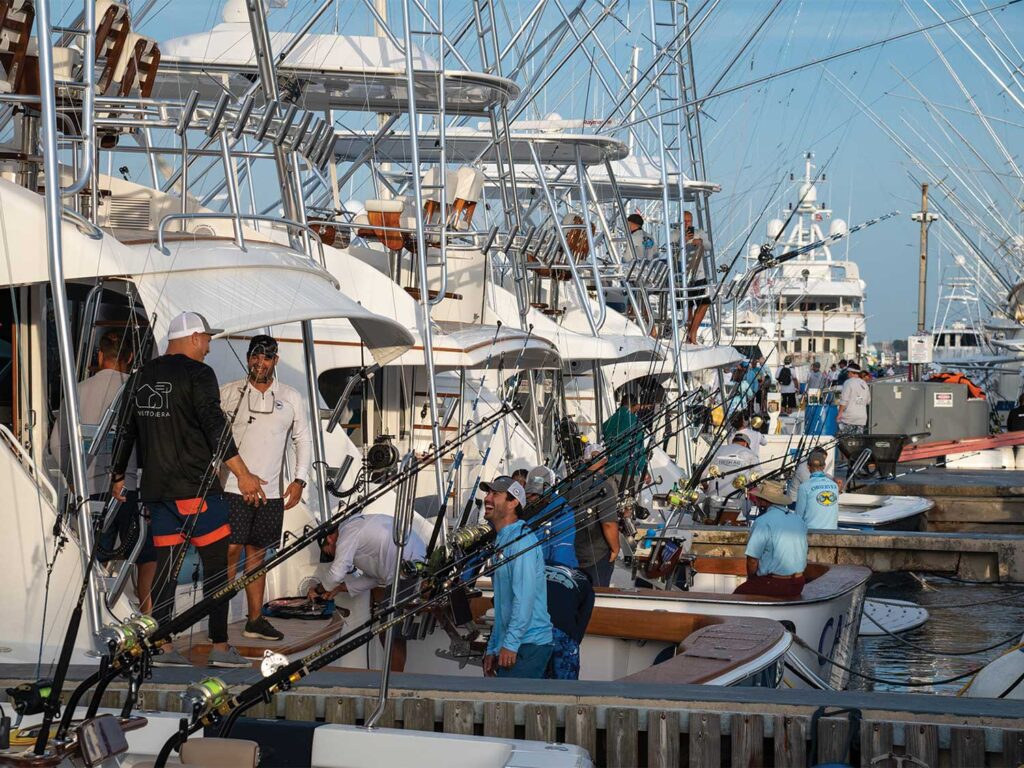
Easy Travel, Good Times
Visitors will usually fly into Luis Muñoz Marín International Airport, located in the community of Carolina, just 3 miles southeast of San Juan. No passports are necessary for US citizens; travelers just need a US federal- or state-issued photo ID, although a passport is recommended. If you’re fishing the tournament as a visiting angler, the tournament will arrange complimentary hotel transfers from the airport—just look for an event representative in baggage claim. Some prefer to bring their own rods and gear, but it’s not necessary.
Club Náutico is situated in an ideal location with easy access to great hotels and restaurants, including the world-renowned Vanderbilt Hotel. A trip to San Juan wouldn’t be complete without a stop at Fort Morro, the old Spanish fortress that guards the entrance to San Juan Harbor. It offers commanding views of the surrounding seas from its upper levels. Old San Juan is historic and easily seen on foot. Uber rides are quick and economical—a better choice than the city’s notoriously unreliable taxis.
Any ladies who are not interested in fishing the tournament are offered a complete schedule of guided island tours, shopping excursions, private luncheons and more, guided by members of the ladies committee from Club Náutico. At the end of the day, they’re waiting back at the club when the boats to return and the dock parties get cranked up. It’s a great time for the spouses who are often overlooked in many other billfish tournaments.
